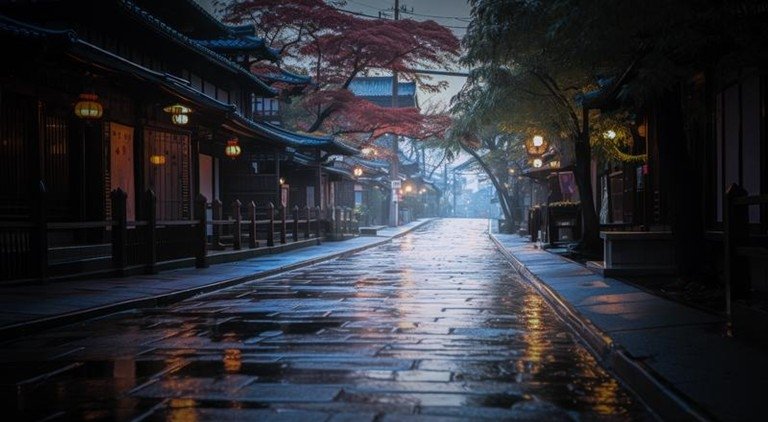51. Ochiba (落葉)
Definition:
Fallen leaves that symbolize the passage of time.
Explanation:
Ochiba captures the transient beauty of autumn as leaves gently descend from trees. It serves as a reminder of the natural cycles of change and the impermanence inherent in life.
52. Amaoto (雨音)
Definition:
The soothing sound of rain.
Explanation:
Amaoto evokes a sense of calm and introspection. The gentle patter of raindrops creates a meditative atmosphere, connecting us deeply to nature’s rhythm.
53. Kurenai (紅)
Definition:
A deep, vibrant crimson.
Explanation:
Kurenai represents passion and intensity. Often found in autumn leaves or traditional textiles, it adds a dramatic flair and rich emotional depth to visual art and nature.
54. Kirameki (煌)
Definition:
A sparkling or glimmering quality.
Explanation:
Kirameki captures those fleeting moments when light dances and reflects in dazzling patterns, symbolizing hope and the beauty in even the smallest details.
55. Moegi (萌黄)
Definition:
The fresh, tender green of new growth.
Explanation:
Moegi embodies the essence of spring. It evokes images of young leaves and budding plants, symbolizing renewal, vitality, and the promise of new beginnings.
56. Sanzen (燦然)
Definition:
A dazzling brilliance that shines radiantly.
Explanation:
Sanzen reflects an overwhelming display of light and color. It evokes a sense of awe through its intense, captivating luminosity in natural and artistic settings.
57. Sensai (繊細)
Definition:
Delicacy and refined subtlety.
Explanation:
Sensai emphasizes the beauty found in intricate details and the fine nuances of art and nature. It celebrates the understated elegance that often goes unnoticed.
58. Akane (茜)
Definition:
A deep reddish-orange reminiscent of a vibrant sunset.
Explanation:
Akane brings to mind the warm hues of dusk. It conveys both passion and nostalgia, enriching our visual experience with its striking and emotive color.
59. Hoshiakari (星明かり)
Definition:
The soft glow of starlight.
Explanation:
Hoshiakari illuminates the night with a gentle, twinkling light. It invites quiet contemplation of the vast universe and the subtle wonders hidden in the darkness.
60. Yōkō (陽光)
Definition:
Bright, radiant sunlight.
Explanation:
Yōkō symbolizes energy, vitality, and optimism. The nourishing quality of sunlight enlivens nature and imbues our surroundings with warmth and clarity.
61. Amatsuyu (雨露)
Definition:
Dewdrops formed by rain, sparkling on surfaces.
Explanation:
Amatsuyu reflects the transient beauty of nature’s minute details. These delicate droplets capture the freshness and renewal that follows a rainfall.
62. Nyūwa (柔和)
Definition:
A gentle, soft quality in both appearance and demeanor.
Explanation:
Nyūwa conveys a soothing harmony akin to a gentle breeze or a kind smile. It embodies a calming presence that enhances our perception of beauty.
63. Sabi (寂)
Definition:
A sense of quiet solitude or serene loneliness.
Explanation:
Sabi evokes a reflective, sometimes wistful mood. It highlights the beauty and introspection that can be found in moments of solitude and the passage of time.
64. Asagao (朝顔)
Definition:
Morning glory – a flower that blooms in the early hours.
Explanation:
Asagao represents the freshness of a new day. Its brief yet radiant bloom symbolizes the fleeting beauty and promise of the morning.
65. Yuri (百合)
Definition:
Lily – a flower symbolizing purity and refined elegance.
Explanation:
Yuri is celebrated for its graceful form and is often associated with innocence and nobility. It serves as a timeless emblem of delicate beauty.
66. Hasu (蓮)
Definition:
Lotus – a flower that rises pure and beautiful from murky waters.
Explanation:
Hasu represents spiritual awakening and resilience. It embodies the idea that beauty and purity can emerge even from challenging or adverse conditions.
67. Ajisai (紫陽花)
Definition:
Hydrangea – a flower known for its lush, layered blooms.
Explanation:
Ajisai captures the ephemeral charm of rainy seasons and seasonal transitions. Its delicate, shifting colors evoke a sense of wistful beauty and natural grace.
68. Botan (牡丹)
Definition:
Peony – a flower admired for its opulent, luxurious bloom.
Explanation:
Botan exudes grandeur and elegance, frequently celebrated in traditional art and culture. It symbolizes wealth, honor, and a majestic form of beauty.
69. Matsukaze (松風)
Definition:
The rustling wind through pine trees.
Explanation:
Matsukaze evokes the soothing, natural melody created by wind whispering among ancient pines. It symbolizes timelessness and the serene voice of nature.
70. Tsuyukusa (露草)
Definition:
A delicate dew plant noted for its subtle beauty.
Explanation:
Tsuyukusa represents the quiet charm of nature’s small wonders. It reminds us to appreciate the resilient beauty found in even the most unassuming elements of the natural world.
71. Nagi (凪)
Definition:
Calm or stillness, especially in the sea or atmosphere.
Explanation:
Nagi embodies the peaceful moments when movement ceases. It offers a sense of tranquility and introspection amid the often hectic pace of life.
72. Ryūsui (流水)
Definition:
Flowing water – the continuous, unending stream.
Explanation:
Ryūsui symbolizes the perpetual flow and renewal of life. It reflects both physical movement and the metaphorical journey of time with graceful persistence.
73. Ogawa (小川)
Definition:
A small, gentle stream.
Explanation:
Ogawa suggests a quietly meandering waterway that nurtures its surroundings. It embodies the understated beauty of nature’s simpler forms.
74. Kohan (湖畔)
Definition:
Lakeside – the tranquil shore of a lake.
Explanation:
Kohan represents the serene meeting point between water and land. It is a place of reflection and calm, where nature mirrors its own beauty in still waters.
75. Shimo (霜)
Definition:
Frost – the delicate, crystalline formation on surfaces in cold weather.
Explanation:
Shimo captures the fleeting beauty of winter’s chill. The intricate, transient patterns of frost evoke a sense of wonder and the quiet artistry of nature during cold mornings.


Comments